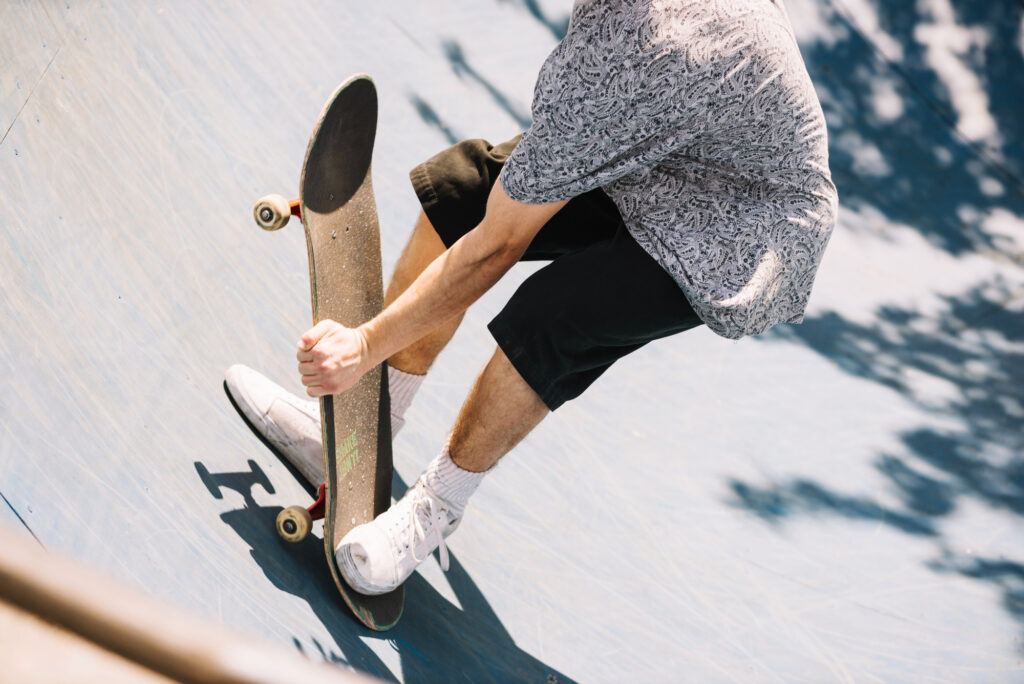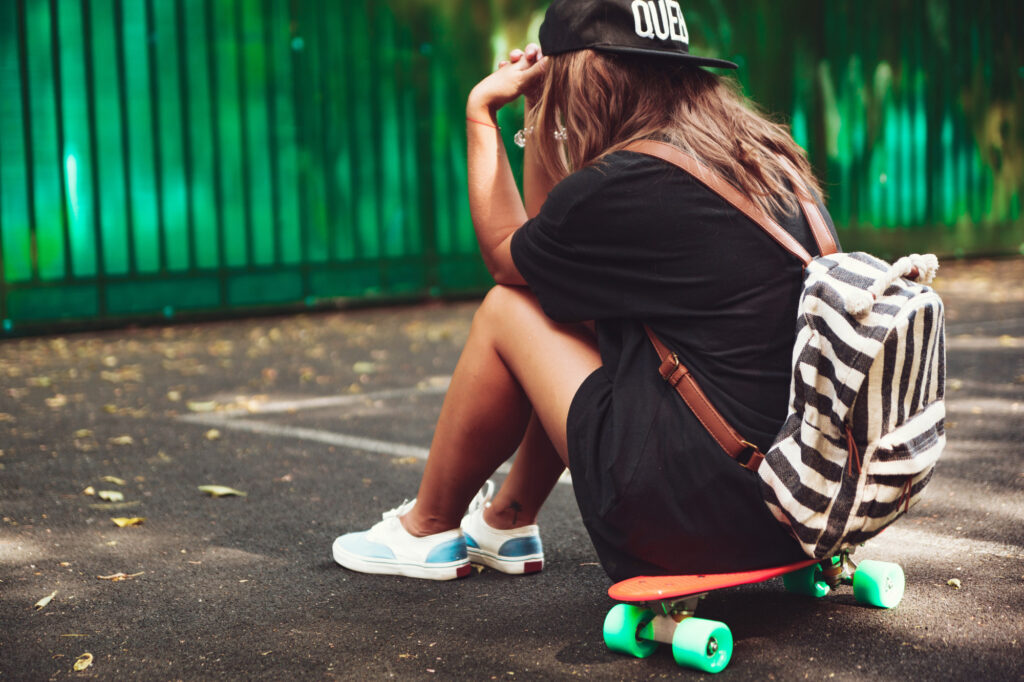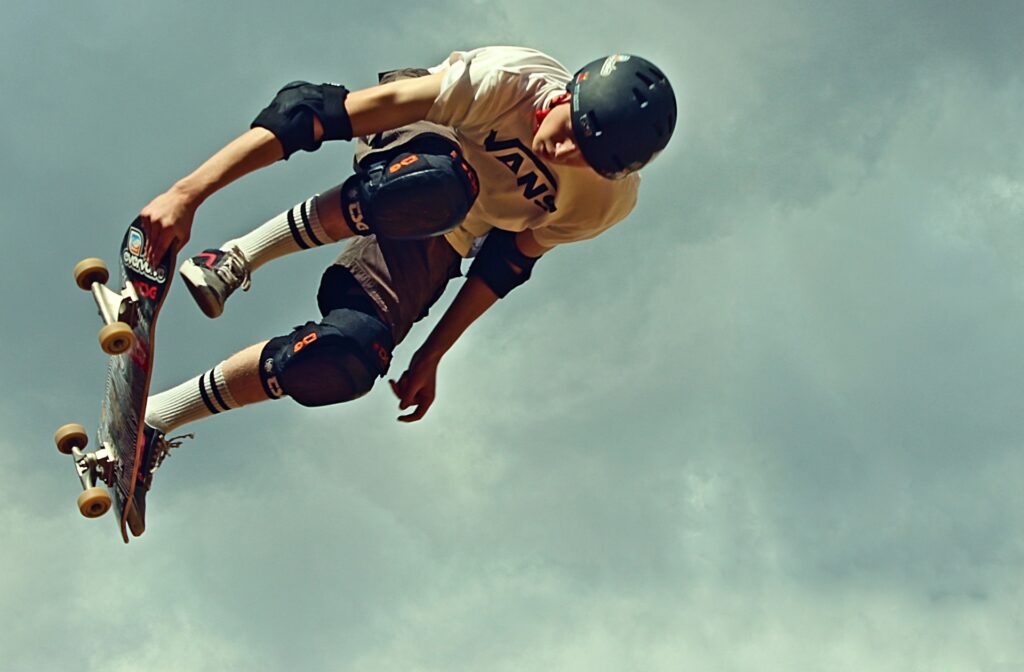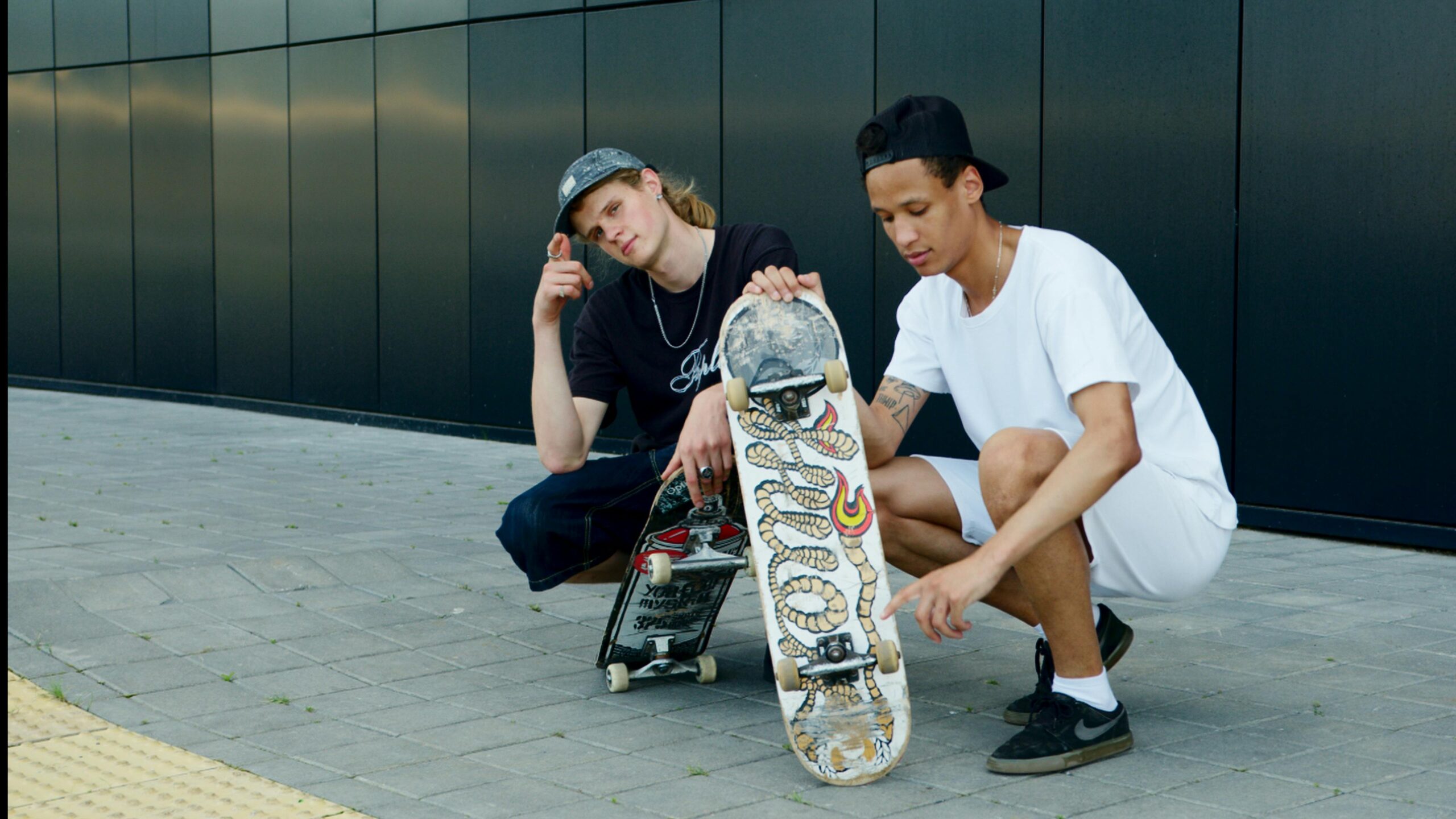Skateboarding is an adventurous and thrilling sport that gives people a feeling of excitement and freedom. It’s not just an activity, it’s a culture that people of all ages enjoy. But as fun and adrenaline-pumping as the sport is, it also carries a risk of injury. Thousands of people end up in hospital each year with skateboarding injuries. These injuries are quite common and can happen to anyone from beginners to experienced skaters.
Skateboarding injuries can happen in many different ways – from minor cuts and bruises to serious fractures, sprains and head injuries. The most common injuries are seen in the wrists, ankles and knees, but sometimes they can also affect the back and head. These injuries can be caused by just one wrong move, losing balance or not wearing safety gear.
In this article, we will explain in detail how skateboarding injuries occur and the best ways to prevent them. Prevention is very important because even a small injury can keep you away from skateboarding for a long time. Using proper safety gear, correct technique and regularly improving your skills can help minimize injuries. In addition, it is important to understand the proper treatment and recovery process if you do get injured.
Whether you are a beginner who is just learning something new or an experienced skater who is trying new tricks, this guide will be very helpful for your safety and performance. By investing a little time and effort to avoid skateboarding injuries, you can make your skateboarding experience even more enjoyable and long-lasting. So let’s learn about the common types of skateboarding injuries, their prevention and treatment so that you can safely pursue your passion.
Common Types of Skateboarding Injuries
Skateboarding is fun and thrilling, but injuries are quite common – whether you are a beginner or an expert. These injuries occur in different ways, but some injuries are the most severe that every skater may have to face. Let’s learn about some common types of skateboarding injuries:
Wrist Fractures and Sprains
Whenever a skater falls, the first hand he moves forward to protect himself. This puts a lot of pressure on the wrists and fractures or sprains are quite common. If you are not wearing wrist guards when you fall, the injury can be even more serious.
Ankle Injuries (Sprains and Fractures)
The ankle is also put under a lot of stress during skateboarding, especially when you attempt tricks or jumps. If the landing is not correct, the ankle can get twisted, increasing the risk of a sprain or fracture. This injury is quite common for beginners as well as experienced skaters.
Knee Injuries
The knee is also affected a lot during skateboarding. Improper landing or a sudden twist can tear ligaments or meniscus. These injuries are quite painful and the recovery time is also longer.
Head Injuries (Concussions)
Head injuries are the most dangerous, and they occur when the skater falls and hits his head on the ground. Not wearing a helmet can make the head injury quite severe, with a risk of concussion or even skull fracture.
Elbow and Shoulder Injuries
If you take impact with your elbows or shoulders while falling, they can be dislocated, fractured or sprained. These injuries are also quite painful and can restrict movement to a great extent.
Cuts and Bruises
Minor cuts and bruises are a part of skateboarding. It is common to get scrapes, cuts and bruises after a fall. These are minor injuries but if you are not wearing the proper gear, the risk of infection can increase.
Back Injuries
If you do too many flips or high jumps while skateboarding, the back is put under a lot of stress. Sometimes a fall can cause a back injury that is very painful and lasts a long time.

Causes and Risk Factors of Skateboarding Injuries
There are many causes of skateboarding injuries, and they are often due to wrong technique, overconfidence or not wearing safety gear. The most common cause is improper balance and control. When a skater loses his balance on the board, the risk of falling increases. This is more common with beginners who have not yet developed proper control over the board.
Skateboarding on rough or uneven surfaces is also a major risk factor. Sidewalks, roads or areas with cracks or obstacles have a higher chance of falling and getting injured. Apart from this, high-speed skateboarding is also quite dangerous, because at high speed the skater loses control and if he falls, the injury is serious.

Another big cause is wrong execution of tricks and stunts. If the body posture is not correct while doing tricks or the landing technique is wrong, then injuries like fractures and sprains can occur. Especially while skateboarding on ramps and rails, this risk increases even more.
Not wearing safety gear is also a big factor for injuries. If the skater does not wear helmet, wrist guards and knee pads, then even a small fall can turn into a major injury. Fatigue and lack of focus are also important risk factors. When a skater is tired or not paying attention, a small mistake can result in an injury. Often, inexperience and reckless behavior are the biggest causes of injuries. Sometimes skaters ignore their limits and try new and difficult stunts that are above their skill level. This increases the chance of injuries. Therefore, it is important to practice according to your skills and pay attention.
Prevention Strategies for Skateboarding Injuries
Preventing skateboarding injuries isn’t difficult; a little attention and the right safety measures are enough. The first and most important thing is the use of safety gear. Wearing helmet, elbow pads, knee pads and wrist guards are always helpful. This gear protects your joints and head if you fall and greatly reduces the risk of fractures or head injuries.

Proper footwear is also important. You should wear shoes that are designed for skateboarding – they have good grip and help you maintain balance. Wearing regular sneakers or flip-flops while skateboarding can be risky as they reduce control of the board. Using proper technique and form is also very important. You should focus on balance, body posture and board control. If you’re a beginner, it’s a good idea to seek professional training or practice by watching tutorials. Develop your skills gradually and try advanced tricks only after you’ve understood the basic techniques.
Properly inspecting the skateboarding area is also a part of injury prevention. Always skateboard in a place that is smooth and obstacle-free. Avoid cracks, potholes and uneven surfaces as these are the biggest risk factors for falling. Skate parks are the best places as they are specially designed for skateboarding. It is also important to understand your limits and avoid overconfidence. Every skater should practice according to his skill level. If you are tired or not focused, avoid skateboarding as accidents also occur due to fatigue.
Lastly, warming up and stretching is a must before practice. It makes the muscles flexible and reduces the risk of sprains and strains. If you follow these prevention tips, skateboarding injuries can be significantly reduced and you can enjoy your sport safely.
How to Treat Skateboarding Injuries
Treatment of Minor Cuts and Bruises
Cuts and bruises are quite common from falling while skateboarding. They are easy to treat:
Clean the wound: First wash the cut or bruise with clean water and an antiseptic to prevent infection.
Apply antibiotic: Apply antibiotic ointment to the wound and cover it with a bandage.
Apply ice: Applying an ice pack to the bruised area reduces swelling and pain.
Treatment of Sprains and Strains
Sprains and strains are common in the ankles, wrists and knees. These injuries occur when muscles or ligaments are pulled or stretched.
R.I.C.E. Method:
- Rest: It is most important to give rest to the injured area.
- Ice: Immediately after the injury, apply an ice pack for 15-20 minutes.
- Compression: Wrap it with an elastic bandage to reduce swelling.
- Elevation: Control swelling and pain by keeping the injured area above heart level.

Fractures and Broken Bones
It is important to seek immediate medical attention if a fracture occurs.
Immobilize: Stop the injured area from moving and immobilize it. If there is an arm or leg fracture, use a splint.
Consult a doctor: Go to a doctor immediately for X-rays and proper diagnosis.
Casting and Surgery: Whether a cast will be applied or surgery will be required depends on the severity of the fractures.
Head Injuries (Concussion)
Head injuries are quite dangerous and should not be taken lightly. If the head hits the ground while falling, there is a risk of concussion.
Monitor symptoms: Dizziness, nausea, confusion or memory loss can be signs of concussion.
Rest and Observation: Rest is a must after a head injury. If symptoms persist, it is important to see a doctor.
CT Scan: In severe cases, a CT scan may be needed to diagnose any internal injury.
Dislocations and Joint Injuries
Joints, such as shoulders and elbows, can get dislocated while skateboarding.
Prevent the joint from moving: Immobilize the injured joint and seek medical help immediately.
Get a pop back from the doctor: Only a professional can put the dislocated joint back in place.
Rehabilitation: Physiotherapy may be needed to make the joint strong again.
Back and Spine Injuries
Back injuries can be quite serious and it is important to get the right treatment for them.
Rest and apply ice: Apply ice on the injured back to reduce swelling and pain.
Physical Therapy: In severe cases, physiotherapy and regular exercises help to heal the back.
Consult a doctor: If back pain continues or is severe, it is important to see a spine specialist.
Recovery Tips
Consistent rest and patience: It takes time to recover from injuries. Do not exert yourself in the hope of recovering quickly.
Rehabilitation Exercises: Follow the exercises prescribed by the doctor or physiotherapist to regain strength and flexibility.
Proper Nutrition and Hydration: Healthy diet and hydration speed up the recovery process.

Long-Term Recovery and Rehabilitation
Fully recovering from skateboarding injuries is not just limited to treatment, but long-term recovery and rehabilitation are also an important part. When the initial pain and swelling from an injury subsides, the process of restoring strength and flexibility to the muscles and joints begins. Physiotherapy and regular exercises help a lot so that the body can return to its old form. This is especially important for injuries such as fractures, dislocations and ligament tears.
Stretching and strength training are also important as it makes the injured area flexible and strong again. If this part is skipped, the muscles can remain weak and the risk of future injury can increase. In addition, balance and coordination exercises are also necessary for skateboarding, which improve your overall performance.

Patience and consistency are very important during recovery. Sometimes skaters try to get back to skateboarding too soon, which can worsen the injury. Therefore, you should not go back to skateboarding without the advice of a doctor or physiotherapist. Progressive overload means gradually increasing your level of activity so that the body can be fully prepared for the recovery.
Your diet is also a part of long-term recovery. Eating a diet rich in protein and vitamins helps body tissues heal faster and muscles repair. Also, hydration and proper sleep accelerate recovery. If the injury is more serious, regular check-ups and monitoring are also necessary so that any complications can be caught in time. The goal of long-term recovery is not just to avoid injury but to get the body back skateboarding-ready so that you can improve your skills in a future that is injury-free and confident.
Inspiring Safe Skateboarding Practices
Safe skateboarding is not just a way to avoid injuries, it is a habit that improves your performance and enjoyment in the long term. When skaters take safety practices seriously, they set an example not just for themselves but for other skaters as well. Safe skateboarding means taking responsibility, knowing your boundaries and always keeping your own and others’ safety in mind.
The first and most important thing is regular use of protective gear. Helmets, knee pads and wrist guards are not just for beginners – they are equally important for experienced skaters. Sometimes experienced skaters avoid safety gear, but even a small mistake can cause a serious injury. If experienced skaters wear helmets and pads, new skaters are inspired by them and adopt safe practices.

Respecting and guiding others is also a part of safe skateboarding. Guiding new skaters at skate parks and public spots and telling them about safety is the mark of a responsible skater. If someone is trying new tricks, giving them proper technique and safety tips can help. Regular maintenance and checking the board is also a part of safe skateboarding. Loose trucks, damaged wheels or cracks on your skateboard can cause serious accidents. So, always inspect your board and have it serviced by a professional if needed.
Another important practice is to pay attention to the environment. Skate on smooth and safe surfaces and avoid areas with cracks, potholes or obstacles. Skate parks are the safest places because they are specially designed and the risk of accidents is low. Safe skateboarding is not just about following the rules, it is an attitude and mindset that makes skaters responsible and inspires the community. When skaters ride with safety and discipline, it creates a positive environment that is beneficial for skaters of every level.
Conclusion
In conclusion, skateboarding can be a lot of fun, but it also comes with risks that should not be ignored. Injuries that may occur while skateboarding can range from minor scrapes and bruises to more serious issues that require medical attention. Many of these injuries are preventable if riders take the necessary precautions. Wearing the right gear, such as helmets, knee pads, elbow pads, and wrist guards, is crucial for protecting oneself from harm. Proper protective equipment reduces the impact of falls and helps avoid serious injuries.
It is also important for skaters to understand the types of injuries that are common in the sport. These include wrist sprains, fractures, and head injuries. Knowing how to recognize these injuries can make it easier to seek help when needed. Learning about first aid and how to properly treat minor injuries can speed up the recovery process and prevent complications. Being informed about safety measures and injury management plays a significant role in a rider’s overall experience.
Lastly, prioritizing safety does not have to take the fun out of skateboarding. Riders can still enjoy their time on the board while being careful. Remember that having a good time and staying safe are equally important. Prioritize safety gear and take care of your body to enjoy skateboarding fully. Get out there and ride wisely!


